Tourism in Myanmar
This article needs to be updated. (February 2019) |

Tourism in Myanmar (also known as Burma) is a developing sector. As at 2023, new tourist visa applications resume.[1] Although Myanmar possesses tourist potential, much of the industry remains to be developed. The number of visitors to Burma is small compared to its neighbouring countries. This is primarily due to its political situation. However, after the junta transferred power to the civilian government, the tourism sector saw an increase in tourism arrivals, and in 2012, tourist arrivals surpassed the one million mark for the first time. In 2013, the Tourism Master Plan was created, targeting 7.5 million arrivals by 2020.[2]
Tourism has been developed mainly by Myanmar's government, which has encouraged tourism since 1992. Private enterprises also exist, catering to a wide range of tourists.
In 2010, 791,505 foreign tourists visited Myanmar, with 295,174 foreign tourists entering the country via Yangon International Airport.[3] By 2012, more than 1 million foreign tourists visited Myanmar. In 2013, the number of foreign arrivals reached more than 2.04 million, counting both air and overland arrivals.[2]
Tourism has been promoted by advocacy groups as a method of providing economic benefit to Burmese civilians, and to avoid isolating the country from the rest of the world. Voices for Burma, a pro-democracy advocate group, states, "We believe that small-scale, responsible tourism can create more benefits than harm. So long as tourists are fully aware of the situation and take steps to maximise their positive impact and minimise the negatives, we feel their visit can be beneficial overall. Responsible tourists can help Burma primarily by bringing money to local communities and small businesses, and by raising awareness of the situation worldwide."[4]
A former Burmese tourism minister estimated that 12% of the government revenues are derived from tourism, with the tourism industry contributing US$182 million (2007) to the government's annual budget.[5]
In March 2020, Myanmar has closed its borders to international tourists as a measure to prevent the spread of the COVID-19 pandemic.[6][7] Furthermore, following the 2021 coup, the country became increasingly isolated. Large-scale protests and escalating acts of violence have inflicted significant damage upon Myanmar's economy, including the tourism sector, which has been pushed into a state of decline.[8][9][10]
The country reopened to international flights on April 17, 2022, given the decrease in infection cases and the reopening of neighboring countries. In a statement issued by the committee, the decision to reopen aims to boost the tourism sector and provide favorable conditions for visitors to come and explore Myanmar.[11][12][13]
Statistics[edit]
In the 2010–2011 fiscal year, tourists comprised 73.84% (313,127 arrivals) of overseas visitors, primarily entering the country by air, representing 69.26% of arrivals, followed by land and sea, which represented 29.97% and 0.77% of arrivals respectively.[14] An additional 110,914 visitors arrived through other visa types and represented an additional 26.16% of the total.[14] In 2012, revenues from tourism jumped to over $534 million in 2012, up from $315 million in 2011.[15][16]
Recent data reveals that in 2016, Myanmar welcomed only 2.9 million tourists, marking a 38% decrease compared to the previous year (4.7 million visitors in 2015).[17] According to Rogers, the rosy projections about tourism potential led to significant investments in hotel construction. Data from the Ministry of Hotels and Tourism indicates that within a span of five years (up until 2015), 1,300 hotels were built in Myanmar, with foreign businesses collectively investing $2.7 billion in hotel ventures.[18][19][20]
General trends[edit]
International tourist arrivals to Yangon Entry Point, Mandalay & Bagan Gateways, Nay Pyi Taw Gateway and Border Tourism.[21]
| Year | Tourist arrivals | % Change |
|---|---|---|
| 2022 | 233,487 | |
| 2021 | 130,947 | |
| 2020 | 903,343 | |
| 2019 | 4,346,101 | |
| 2018 | 3,551,428 | |
| 2017 | 3,443,133 | |
| 2016 | 2,907,207 | |
| 2015 | 4,681,020 | |
| 2014 | 3,081,412 | |
| 2013 | 2,044,307 | |
| 2012 | 1,058,995 | |
| 2011 | 816,369 | |
| 2010 | 791,505 | |
| 2009 | 762,547 | |
| 2008 | 731,230 |
Tourists by nationality[edit]
The governmental statistics body, the Central Statistical Organization, reported more than 3,000,000 travellers flocked to Myanmar in 2014, compared with approximately 816,000 visitors in 2011. Among these, 1,022,081 tourist arrivals (excluding visitors under special entry visas such as social or business visas) were via Yangon International Airport.[22][23]
Most visitors arriving to Myanmar on short-term basis were from the following countries of nationality:[24]
| Rank | Country | 2019 | 2018 | 2017 | 2016 | 2015 | 2014 | 2013 | 2012 | 2011 |
|---|---|---|---|---|---|---|---|---|---|---|
| 1 | 749,719 | 333,085 | 212,642 | 183,886 | 147,977 | 125,609 | 90,550 | 70,805 | 62,018 | |
| 2 | 273,157 | 291,231 | 273,889 | 243,443 | 204,539 | 198,229 | 139,770 | 94,342 | 61,696 | |
| 3 | 125,706 | 104,376 | 101,484 | 100,084 | 90,312 | 83,434 | 68,671 | 47,690 | 21,321 | |
| 4 | 111,794 | 72,852 | 65,829 | 64,397 | 63,715 | 58,472 | 54,934 | 34,805 | 22,524 | |
| 5 | 66,757 | 65,057 | 73,085 | 76,502 | 69,015 | 62,631 | 53,653 | 37,589 | 21,680 | |
| 6 | 57,890 | 58,657 | 61,859 | 50,198 | 45,125 | 47,692 | 39,140 | 26,296 | 15,391 | |
| 7 | 52,567 | 53,329 | 58,919 | 48,869 | — | — | — | — | — | |
| 8 | 44,703 | 47,632 | 47,010 | 43,931 | 40,852 | 46,534 | 39,758 | 30,499 | 23,287 | |
| 9 | 48,400 | 43,281 | 41,623 | 38,537 | 34,638 | 32,306 | 21,042 | 16,868 | 12,318 | |
| 10 | 42,508 | 43,218 | 58,369 | 52,304 | 47,235 | 41,453 | 35,462 | 30,064 | 19,414 | |
| 11 | 33,857 | 36,609 | 47,717 | 51,051 | 45,120 | 40,921 | 33,203 | 24,296 | 11,056 | |
| 12 | 29,447 | 28,838 | 39,952 | 39,044 | 35,727 | 32,265 | 27,712 | 23,063 | 14,006 | |
| 13 | 25,867 | 27,962 | 32,628 | 34,010 | 30,820 | 29,175 | 11,728 | 18,261 | 10,415 | |
| 14 | 19,121 | 16,855 | 18,242 | 17,969 | 14,821 | 12,613 | 11,728 | 10,830 | 9,710 | |
| 15 | 17,398 | 16,748 | 18,143 | 16,421 | — | — | — | — | — | |
| 16 | 13,589 | 11,315 | 13,558 | 12,765 | — | — | — | — | — | |
| 17 | 11,050 | 11,065 | 14,068 | 15,024 | 14,051 | 12,268 | 8,975 | 6,485 | 3,685 | |
| 18 | 9,257 | 10,019 | 13,558 | 13,694 | 13,897 | — | — | — | — | |
| 19 | 9,500 | 9,428 | 13,950 | — | — | — | — | — | — | |
| 20 | 32,005 | 7,183 | — | — | — | — | — | — | — | |
| 21 | 39,374 | 35,685 | — | — | — | — | — | — | — |
Tourist attractions[edit]
The most popular available tourist destinations in Myanmar include big cities such as Yangon and Mandalay; religious sites in Mon State, Pindaya, Bago and Hpa-An; nature trails in Inle Lake, Kalaw, Kengtung, Putao, Pyin Oo Lwin; ancient cities such as Bagan and Mrauk-U; as well as beaches in Nabule Ngapali, Maungmagan Ngwe-Saung, Mergui.[25]

Kachin State[edit]
- Myitkyina
- Putao
- Bamho
- Hugaung Plain
Yangon[edit]

Mandalay[edit]
Mon State[edit]
- Kyaiktiyo Pagoda
- Mudon (the world's largest reclining Buddha)
- Mawlamyine
- Thanbyuzayat (WWII Death Railway)
Rakhine State[edit]

Shan State[edit]
Other beaches[edit]
Ecotourism[edit]
- Myeik Archipelago
- Hukawng Valley
- Hkakabo Razi
- Alaungdaw Kathapa National Park
- Popa Mountain National Park
- Mount Victoria National Park
UNESCO World Heritage Sites in Myanmar[edit]
| Site | Image | Location | Criteria | Area ha (acre) |
Year | Description | Refs |
|---|---|---|---|---|---|---|---|
| Pyu city-states |   
|
Myanmar| |
Cultural: (ii), (iii), (iv) |
5,809 ha (proper); 6,790 ha (buffer zone) | 2014 | The site includes three of the six main Pyu city-states, namely Halin, Beikthano and Sri Ksetra. | [32] |
| Bagan | 
|
Mandalay Region | Cultural | 2018 | The site includes all of the monuments throughout the ancient capital of the Pagan kingdom. | [33] |
Tentative list to be added[edit]
| Site | Image | Location | Proposed criteria | Year Listed as Tentative Site | Description | Refs |
|---|---|---|---|---|---|---|
| Wooden Monasteries of Konbaung Period: Ohn Don, Sala, Pakhangyi, Pakhannge, Legaing, Sagu, Shwe-Kyaung (Mandalay) | 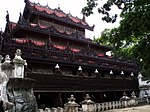
|
Multiple locations | Cultural | 1996 | The site includes seven wooden monasteries, nameyly, Ohn Don, Sala, Pakhangyi, Pakhannge, Legaing, Sagu, and Shwe-Kyaung (Mandalay). | [34] |
| Badah-lin and associated caves | 
|
Shan State | Cultural | 1996 | The site includes various caves used as workshop and rock painting sites in the Paleolithic to Neolithic periods. | [35] |
| Ancient cities of Upper Myanmar: Innwa, Amarapura, Sagaing, Mingun, Mandalay |   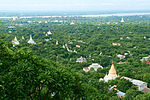  
|
Multiple locations | Cultural | 1996 | The site includes the historic cities of Innwa, Amarapura, Sagaing, Mingun, Mandalay | [36] |
| Myauk-U Archaeological Area and Monuments | 
|
Rakhine State | Cultural | 1996 | The site includes all monuments built by the Arakanese kingdom's capital between the 15th to 16th centuries. | [37] |
| Inle Lake | 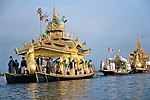
|
Shan State | Cultural | 1996 | The site includes the mountain lake and its preserved cultural landscape. | [38] |
| Mon cities: Bago, Hanthawaddy | 
|
Bago Region | Cultural | 1996 | The site includes all monuments in Bago, formerly called Hanthawaddy. | [39] |
| Ayeyawady River Corridor | 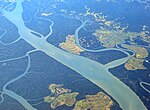
|
Multiple locations | Natural | 2014 | The site includes three main segments, namely Mingun to Kyauk Maung segment, Moda Section,Takaung to Shwegu segment, and Shwegu to Bhamo segment. | [40] |
| Hkakabo Razi Landscape | Kachin State | Natural | 2014 | The site includes Hkakabo Razi National Park and Hponkan Razi Wildlife Sanctuary, along with a proposed Southern Extension of Hkakabo Razi National Park. | [41] | |
| Indawgyi Lake Wildlife Sanctuary | 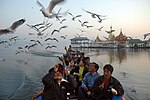
|
Kachin State | Natural | 2014 | The site includes the entire Indawgyi lake. | [42] |
| Natma Taung National Park | 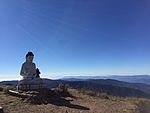
|
Chin State | Natural | 2014 | The site includes Nat Ma Taung, the highest point in Chin State. | [43] |
| Myeik Archipelago | 
|
Tanintharyi Region | Natural | 2014 | The site includes more than 800 islands of primarily limestone and granite. The archipelago is home to the Moken people. | [44] |
| Hukaung Valley Wildlife Sanctuary | 
|
Kachin State | Natural | 2014 | The site is highly significant in the conservation of Indochinese tigers. | [45] |
| Taninthayi Forest Corridor | 
|
Taninthayi Region | Natural | 2014 | The site is an important mixed deciduous forest with bamboo clumps as well as grassland and is a thriving site for the endangered Gurney's pitta. | [46] |
Historical Politics[edit]
In May 2011, Aung San Suu Kyi and her party National League for Democracy expressed the opinion that responsible tourism to Burma should be encouraged. Other pro-democracy activists, such as Ma Thanegi, advocated small scale tourism, and careful spending. Tourists are welcome to Burma provided they are "keen to promote the welfare of the common people and the conservation of the environment and to acquire an insight into the cultural, political and social life of the country while enjoying a happy and fulfilling holiday in Burma."[47][48] In their official statement they request not only the development of the people's livelihood but also the promotion of "self respect and self-reliance in the people."[49]
See also[edit]
References[edit]
- ^ "Foreign travel advice Myanmar (Burma)". Foreign, Commonwealth and Development Office. Retrieved 1 February 2022.
- ^ a b "Amid Burma Tourism Boom, Calls for Govt to Aid Development". 6 January 2014. Retrieved 9 January 2014.
- ^ Feng, Yingqiu (1 June 2011). "Myanmar continues efforts in developing tourism". Xinhua. Archived from the original on 3 June 2011. Retrieved 16 July 2011.
- ^ Voices For Burma's tourism policy http://www.voicesforburma.org/
- ^ "Report on Tourism in Burma" (PDF). Info Birmanie. March 2011. Archived from the original (PDF) on 5 January 2012. Retrieved 16 July 2011.
{{cite journal}}: Cite journal requires|journal=(help) - ^ VTV, BAO DIEN TU (28 August 2020). "Số ca mắc COVID-19 tăng, Myanmar đóng cửa trường học trên toàn quốc". BAO DIEN TU VTV (in Vietnamese). Retrieved 16 August 2023.
- ^ "Đông – Nam Á trong đại dịch Covid-19". Báo Nhân Dân điện tử (in Vietnamese). 17 March 2020. Retrieved 16 August 2023.
- ^ "Myanmar mở cửa cho khách quốc tế". bvhttdl.gov.vn (in Vietnamese). Retrieved 16 August 2023.
- ^ "Biểu tình lớn nhất tại Myanmar trong hơn một thập niên". BBC News Tiếng Việt (in Vietnamese). 7 February 2021. Retrieved 16 August 2023.
- ^ "Thiết quân luật được mở rộng sau ngày đẫm máu ở Myanmar". BBC News Tiếng Việt (in Vietnamese). 15 March 2021. Retrieved 16 August 2023.
- ^ VnExpress. "3 quốc gia châu Á vẫn kiểm dịch Covid-19 với khách du lịch". vnexpress.net (in Vietnamese). Retrieved 16 August 2023.
- ^ VTV, BAO DIEN TU (19 March 2022). "Myanmar mở cửa đón du khách quốc tế từ ngày 17/4". BAO DIEN TU VTV (in Vietnamese). Retrieved 16 August 2023.
- ^ "Myanmar mở lại sân bay quốc tế Yangon sau hai năm". caa.gov.vn. Retrieved 16 August 2023.
- ^ a b "Table 29.OVERSEAS VISITORS". Central Statistical Organization. Ministry of National Planning and Economic Development. Archived from the original on 7 October 2011. Retrieved 16 July 2011.
- ^ "Tourist income surges 70% in Myanmar". Investvine.com. 25 January 2013. Retrieved 5 February 2013.
- ^ "Myanmar tours". www.myanmartours.net. Retrieved 16 August 2023.
- ^ thanhnien.vn (9 July 2017). "Du lịch Myanmar ế ẩm". thanhnien.vn (in Vietnamese). Retrieved 16 August 2023.
- ^ "Giấc mơ du lịch của Myanmar đang phai nhạt?".
- ^ "Myanmar Tours". www.myanmartours.net. Retrieved 16 August 2023.
- ^ ONLINE, TUOI TRE (8 August 2022). "Hướng dẫn mới về việc xin thị thực du lịch Myanmar". TUOI TRE ONLINE (in Vietnamese). Retrieved 16 August 2023.
- ^ "Tourism of Myanmar".
- ^ "Myanmar Tourism Statistics 2014" (PDF). Central Statistical Organization. Ministry of National Planning and Economic Development. Archived from the original (PDF) on 14 January 2016. Retrieved 5 January 2016.
- ^ "Archived copy" (PDF). Archived from the original (PDF) on 29 December 2016. Retrieved 5 January 2016.
{{cite web}}: CS1 maint: archived copy as title (link) - ^ "Myanmar Tourism Statistics". Ministry of Hotels and Tourism.
- ^ "Myanmar Travel Agency". birma.com. p. Tourist Destinations. Retrieved 20 October 2013.
- ^ Planet, Lonely. "Kalaw travel | Myanmar (Burma)". Lonely Planet. Retrieved 7 May 2019.
- ^ "THE 5 BEST Things to Do in Kalaw - 2019 (with Photos) - TripAdvisor". www.tripadvisor.com. Retrieved 7 May 2019.
- ^ "Kalaw information". Go-Myanmar.com. Retrieved 7 May 2019.
- ^ "Shan State – Ministry of Hotels & Tourism Myanmar". Retrieved 7 May 2019.
- ^ Dunham, Jillian (16 December 2015). "A Three-Day Trek in the Highlands of Myanmar". The New York Times. ISSN 0362-4331. Retrieved 7 May 2019.
- ^ "TripAdvisor: Read Reviews, Compare Prices & Book". TripAdvisor. Retrieved 7 May 2019.
- ^ "Chitwan National Park". UNESCO. Retrieved 28 May 2010.
- ^ "Bagan".
- ^ "Wooden Monasteries of Konbaung Period: Ohn Don, Sala, Pakhangyi, Pakhannge, Legaing, Sagu, Shwe-Kyaung (Mandalay)".
- ^ "Badah-lin and associated caves".
- ^ "Ancient cities of Upper Myanmar: Innwa, Amarapura, Sagaing, Mingun, Mandalay".
- ^ "Mrauk-U".
- ^ "Inle Lake".
- ^ "Mon cities: Bago, Hanthawaddy".
- ^ "Ayeyawady River Corridor".
- ^ "Hkakabo Razi Landscape".
- ^ "Indawgyi Lake Wildlife Sanctuary".
- ^ "Natma Taung National Park".
- ^ "Myeik Archipelago".
- ^ "Hukaung Valley Wildlife Sanctuary".
- ^ "Taninthayi Forest Corridor".
- ^ Kerr, Michael (12 April 2012). "Burma: how can holidaymakers visit ethically?". The Daily Telegraph. Retrieved 20 October 2013.
- ^ Norton, Charlie (14 August 2009). "Burma opposition leader Suu Kyi: 'Tourism might help'". The Daily Telegraph. Retrieved 20 October 2013.
- ^ "NLD statement No 10/05/11 released on 20th May 2011 regarding tourism in Burma". National League for Democracy. 20 May 2011. Archived from the original on 10 November 2013. Retrieved 20 October 2013.
